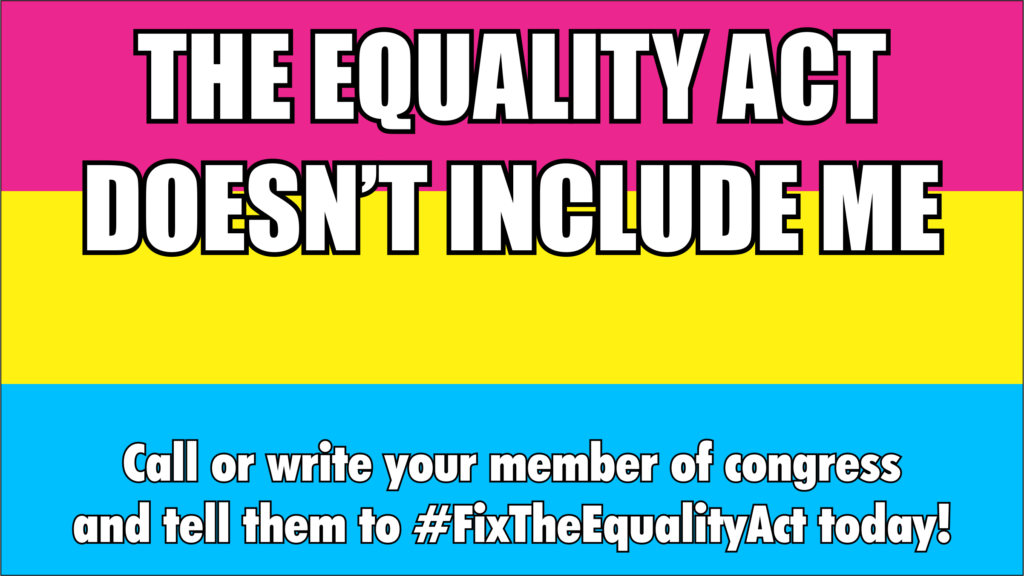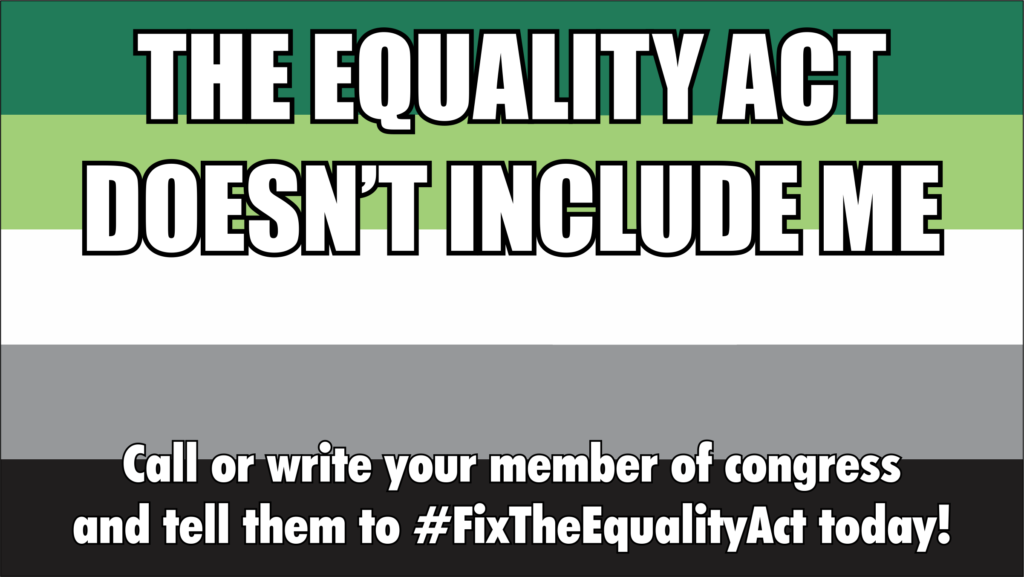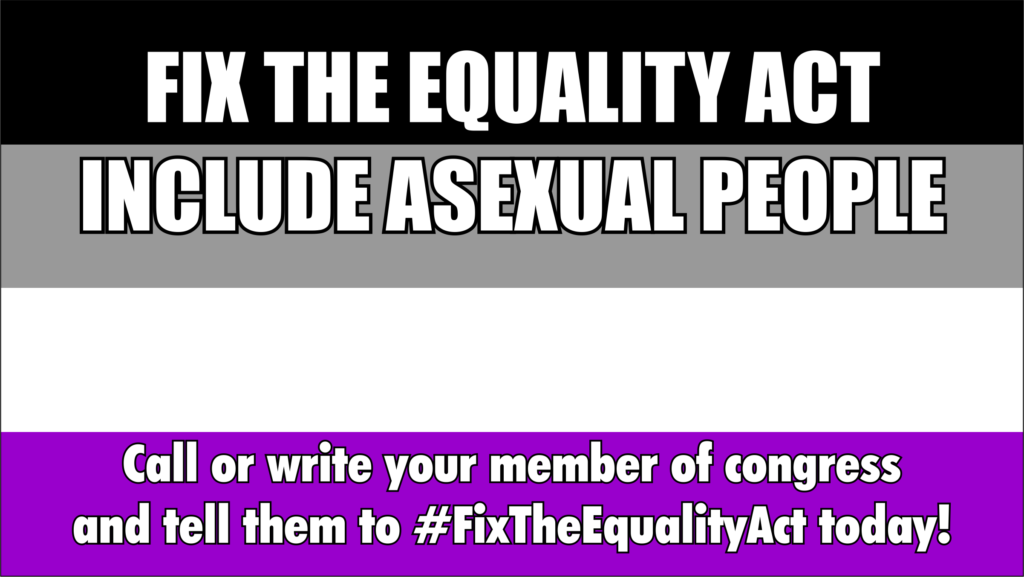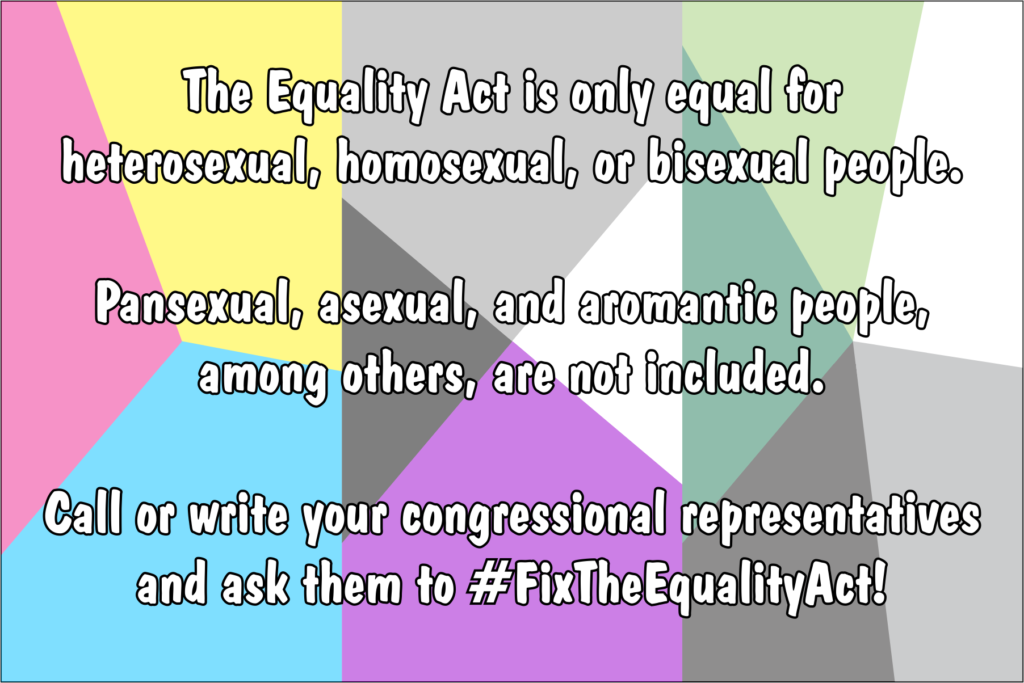[Update: Visit the Inclusive Equality Act Coalition for more information.]
Last year, I wrote a couple of things about the law and how it relates to asexuality and aromanticism. Spoiler alert: Asexuality and aromanticism are left out of anti-discrimination laws pretty much everywhere.
One particularly notable example of this is the federal Equality Act, an update to the Civil Rights Act to make sexual orientation and gender identity explicitly covered by its protections. While the recent decision in the Bostock case sets a good precedent that can be applied in many other areas (including potentially the rest of the Civil Rights Act), there is still a need to codify it into law so there’s no wiggle room or space for interpretation or opportunity for a future court to simply change their minds.
The problem with the Equality Act is that it defines “sexual orientation” as specifically “homosexuality, heterosexuality, or bisexuality.” This is an outdated and limited definition, which does not cover the full diversity of orientations that we recognize today. Aros and aces are left in the cold, along with pansexual people and others.
So let’s fix that.
We need to get ahead of the problem and update that language to close that loophole, before it can be exploited. I’m proposing language based on the New York City Human Rights Law (NYC Admin. Code, Title 8, Chapter 1, Section 102):
“The term ‘sexual orientation’ means an individual’s actual or perceived romantic, emotional, physical or sexual attraction to other persons, or lack thereof, on the basis of gender. A continuum of sexual orientation exists and includes, but is not limited to, heterosexuality, homosexuality, bisexuality, asexuality, pansexuality, and aromanticism.”
This language recognizes attraction types beyond just sexual attraction. It also protects people who lack attraction of any particular type. And it explicitly includes asexual, pansexual, and aromantic people. The original NYC law did cover a lack of romantic attraction, but did not explicitly mention aromanticism at all.
However, I recognize that this is an imperfect definition, combining multiple types of attraction all under the umbrella of “sexual orientation”. I’m proposing this purely as a pragmatic measure:
- The existing language of the Equality Act is specifically mentioning “sexual orientation” in many places. To change that language would involve a large scale rewrite of the bill, and it feels like that would be a harder effort to get passed, as well as just be harder to explain to people who aren’t versed in the nuance.
- This is essentially the language used in the existing NYC law, so it provides a precedent. An imperfect precedent, but a precedent nonetheless.
What Can You Do?
On this page are some tools to help you write to Congress about it as well as reach out to large queer organizations to help get them on board. There are also some graphics you can share. But the most important thing you can do is spread the word. Make some noise. No one will do anything if they don’t know there’s something that needs to be done.
Letter to Congress
The following letter is a sample letter to your congressional representatives, if your representatives are supporters of the bill: House | Senate. (If they’re not a supporter, it’s probably not worth sending this letter, but it might be worth sending a different one urging them to support it.) You can fill in the blanks, and just send it off, but I urge you to personalize it in some way, especially if you live in their district.
Dear [Insert Congressional Name Here]:
I want to thank you for supporting the Equality Act. This is an important bill which will be a huge step along our path to justice for all in our country. Here’s hoping that we’ll be in a position to get it passed and signed next year!
Unfortunately, the act does not protect everyone it should. The definition of “sexual orientation” that it uses is outdated and limited, and excludes a large number of people are aromantic, pansexual, or asexual, among other orientations. I am one of the people this language leaves behind. I ask that you work to update this language to reflect the wide diversity of orientations that we recognize today and into the future.
To that end, I propose this more inclusive definition for “sexual orientation”, based on the language found in the New York City Administrative code (Title 8, Chapter 1, Section 102: https://www1.nyc.gov/site/cchr/law/chapter-1.page#8-102), with a few alterations:
“The term ‘sexual orientation’ means an individual’s actual or perceived romantic, emotional, physical or sexual attraction to other persons, or lack thereof, on the basis of gender. A continuum of sexual orientation exists and includes, but is not limited to, heterosexuality, homosexuality, bisexuality, asexuality, pansexuality, and aromanticism.”
I hope that you are able to work with your colleagues to fix the Equality Act.
Thank you,
[Insert Constituent Name Here]
Letter to LGBTQIA+ Groups
This letter is for queer organizations who have the clout to help push Congress for a more inclusive Equality Act.
Dear [Group]:
I want to thank your organization for supporting the Equality Act. This is an important bill which will be a huge step along our path to justice for all in our country. Here’s hoping that we’ll be in a position to get it passed and signed next year!
Unfortunately, the act does not protect everyone it should. The definition of “sexual orientation” that it uses is outdated and limited, and excludes a large number of people are aromantic, pansexual, or asexual, among other orientations. I am one of the people this language leaves behind. I ask that your organization work with Congress to update this language to reflect the wide diversity of orientations that we recognize today and into the future.
To that end, I propose this more inclusive definition for “sexual orientation”, based on the language found in the New York City Administrative code (Title 8, Chapter 1, Section 102: https://www1.nyc.gov/site/cchr/law/chapter-1.page#8-102), with a few alterations:
“The term ‘sexual orientation’ means an individual’s actual or perceived romantic, emotional, physical or sexual attraction to other persons, or lack thereof, on the basis of gender. A continuum of sexual orientation exists and includes, but is not limited to, heterosexuality, homosexuality, bisexuality, asexuality, pansexuality, and aromanticism.”
I hope that you are able to work with your Congress and your fellow LGBTQIA+ groups to fix the Equality Act.
Thank you,
[Insert Name Here]
Slogans and Hashtags
What kind of activism can be done without snappy slogans and hashtags? So here’s a few suggestions:
- #FixTheEqualityAct
- The Equality Act doesn’t include me.
- I’m not equal under the Equality Act.
- Fix the Equality Act. Include [Asexual People/Aromantic People/Pansexual People]
- “Equality” means all of us. Fix the Equality Act so it covers [Aros/Pan People/Aces].
Images
Here are some images to share. They don’t have a lot of context, so you probably want to include information about what the Equality Act is and what needs to be fixed about it in the caption.







Closing Notes
I don’t have to be the only person pushing for this. I don’t want to be the only person pushing for this. I have no in, no clout, no magic secret to getting the law changed. It’s not “What I say goes”, so please, if you have language that you prefer, please push for that! It doesn’t really matter that we’re all going with exactly the same message, the point is that we’re all pulling in the same general direction.
My take is that the language I’m suggesting here is “close enough for government work” (literally…). The goal here is to include the protection, rather than pass a Queer Theory exam. I don’t want to make the perfect the enemy of the good.
